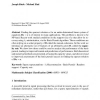Free Online Productivity Tools
i2Speak
i2Symbol
i2OCR
iTex2Img
iWeb2Print
iWeb2Shot
i2Type
iPdf2Split
iPdf2Merge
i2Bopomofo
i2Arabic
i2Style
i2Image
i2PDF
iLatex2Rtf
Sci2ools
CORR
2010
Springer
2010
Springer
Analysis of Basis Pursuit Via Capacity Sets
Finding the sparsest solution for an under-determined linear system of equations D = s is of interest in many applications. This problem is known to be NP-hard. Recent work studied conditions on the support size of that allow its recovery using 1-minimization, via the Basis Pursuit algorithm. These conditions are often relying on a scalar property of D called the mutual-coherence. In this work we introduce an alternative set of features of an arbitrarily given D, called the capacity sets. We show how those could be used to analyze the performance of the basis pursuit, leading to improved bounds and predictions of performance. Both theoretical and numerical methods are presented, all using the capacity values, and shown to lead to improved assessments of the basis pursuit success in finding the sparest solution of D = s. Keywords Sparse representations
| Added | 09 Dec 2010 |
| Updated | 09 Dec 2010 |
| Type | Journal |
| Year | 2010 |
| Where | CORR |
| Authors | Joseph Shtok, Michael Elad |
Comments (0)

